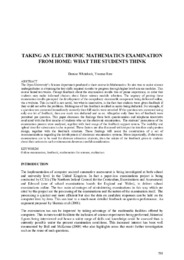Taking an electronic mathematics examination from home: what the students think
Abstract
The Open University’s Science department produced a short course in Mathematics. Its aim was to assist science undergraduates in obtaining the key skills required in order to progress through higher level science modules. This course lasted ten weeks. Prompt feedback about the examination results was of prime importance, in order that students may make informed choices about future science module selection. The urgency of posting these examination results prompted the development of the compulsory examinable component being delivered online, via a website. This in itself is not novel, but what is innovative, is the fact that students were given feedback if they could not solve the problems. Making use of this feedback resulted in marks being deducted. For example, if a question was answered immediately correctly then full marks were awarded. If the question was answered using only one lot of feedback, then one mark was deducted and so on. Altogether only three lots of feedback were permitted per question. This paper discusses the findings from both questionnaires and telephone interviews conducted with the first tranche of students who sat the electronic examination. The students’ perceptions of the examination process were analysed, together with their usage of the feedback support system. The usability and upload time for submission is also reported. These factors are also discussed with respect to interface and question design, together with the feedback structure. These findings will assist the construction of a set of recommendations regarding the development of electronic examination systems. More importantly, if electronic examinations are to be used for distance education students, then the nature of the feedback given to students about their actions in such environments deserves careful consideration.
